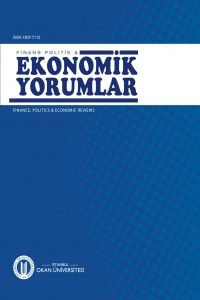Türkiye’de Mali İllüzyon Varlığının Analiz Edilmesi
Mali illüzyon,bütçe açığının dolaylı finansmanının (özellikle dolaylı vergilerin artışı), kamu mal ve hizmetlerinin algılanan maliyetini azaltarak vatandaşların kamu mal ve hizmetlere olan talebinin arttırmasını ve bu durumda kamu harcamalarının yükselmesini ifade etmektedir. Buchanan ve Wagner (1977)’in öne sürdüğü mali illüzyon literatürde çok geniş yer bulmuş bir kavram değildir. Türkiye’de de mali illüzyonu test eden çalışma neredeyse yok denecek kadar azdır. Bu çalışmada Türkiye’de mali illüzyonun varlığı Ocak 2006 - Eylül 2014 dönemi için Hata Düzeltme Modeli kullanılarak incelenmiştir
Anahtar Kelimeler:
Mali İllüzyon, Türkiye, Hata Düzeltme Modeli
The Analysis of Fiscal Illusion in Turkey
Fiscal illusion is the case where the indirect financing of budget deficit (especially with increasing in indirect taxes) increases the citizens’ demand of public goods and services by reducing the perceived costs of public goods and services and so, the increase in public expenditures is seen in this situation. Fiscal illusion highlighted by Buchanan and Wagner (1977) did not create much controversy in the literature. There is rarely any study testing fiscal illusion in Turkey. In this study, the existence of fiscal illusion is examined for the period of 2006 January -2014 September with the Error Correction Model
Keywords:
Fiscal Illusion, Turkey, Error Correction Model,
___
- AKÇORAOĞLU, Alpaslan; (1999). “Kamu Harcamaları, Kamu
- Gelirleri ve Keynesçi Politikalar: Bir Nedensellik Analizi, Gazi Üniversitesi İİBF Dergisi, 2,ss. 51-65. BARUA, Shubhasish; (2005), “An Examination of Revenue and Expenditure Causality in Bangladesh: 1974-2004”, Bangladesh
- Bank Policy Analysis Unit Working Paper Series, No: WP 0605, December.
- BUCHANAN, James ve Richard WAGNER; (1977), Democ- racy in Deficit,AcademicPress, New York.
- BUCHANAN, James; (1960), Fiscal Theory and Political Economy,The University of North Carolina Press, Chapel Hill.
- ÇAKMUR YILDIRTAN, Dina; (2010), E-Views Uygulamalı Temel Ekonometri: Makro Ekonomik Verilerle, Türkmen Kitape- vi, İstanbul, ISBN: 978–605–4259–18–2.
- ÇAVUŞOĞLU, A. Tarkan; (2008), “Türkiye’de Kamu Gelirleri ve Harcamaları Arasındaki İlişki Üzerine Ekonometrik Bir Analiz”
- Dumlupınar Üniversitesi Sosyal Bilimler Dergisi, 20, Nisan, ss.143-160. DARRAT, Ali F.; (1998), “Tax and Spend, or Spend and Tax?
- An Inquiry into the Turkish Budgetary Process”, Southern Eco- nomic Journal, 64 (4), April, pp.940-956. DAS, Amaresh ve Adnan OMAR; (2014), “Fiscal Illusion – Does
- It Exist? An Econometric Evaluation”, International Journal of Economics, Finance and Management, 3 (3), April, pp.136- DOLLERY, Brian E. ve Andrew C. WORTHİNGTON; (1996)
- “The Empirical Analysis of Fiscal Illusion”, Journal of Economic Surveys, 10 (3). pp.261–297. EĞİLMEZ, Mahfi; (2011), “İllüzyon”, Kendime Yazılar, http:// www.mahfiegilmez.com/2011/12/illuzyon.html
- FRIEDMAN, Milton; (1978), “The Limitations of Tax Limitation”, Policy Review, pp.7-14.
- GEMMELL, Norman, Oliver MORRISSEY ve Abuzer PINAR; (1999),“Fiscal Illusion and the Demand for Government Expen- ditures in the UK” European Journal of Political Economy, 15, pp.687–704
- GÜNAYDIN, İhsan; (2000), “Türkiye’de Kamu Gelirleri ve Kamu Harcamaları Arasındaki Nedensel İlişki”, Süleyman Demirel Üniversitesi İİBF Dergisi, 5(1), ss. 55-74
- GÜNAYDIN, İhsan; (2004), “Vergi-Harcama Tartışması: Tür- kiye Örneği”, Doğuş Üniversitesi Dergisi, 5 (2), ss.163-181
- HOOVER, Kevin D. ve Steven M. SHEFFRIN; (1992),“Causa- tion, Spending and Taxes: Sand in the Sandbox or Tax Collec- tor for the Welfare State?”, American Economic Review, 82 (1), March, pp.225–248.
- JOHANSEN, Saren; (1988), “Statistical Analysis of Cointegrat- ing Vectors”, Journal of Economic Dynamics and Control, 12, pp. 231–254.
- KONSTANTINOU,Panagiotis T.; (2004) “Balancing the Bud- get through Revenue or Spending Adjustments? The Case of
- Greece”, Journal of Economic Development, 29 (2), December, pp.81-105. MOURAO, Paulo Reis; (2008), “Political Budget Cycles and Fiscal Illusıon: A Panel Data Study”, Helena MARQUES,Elias
- SOUKIAZIS ve Pedro CERQUEIRA (Eds.), Perspectives on In- tegration and Globalization, Lit Verlag Münster, Berlin, pp..83- MOURAO, Paulo Reis;(2010),“Debate: The Dangers of Fiscal
- Illusion”. Public Money & Management, 30 (5), September, pp. –268, www.tandfonline.com.innopac.up.ac.za/doi/pdf/10.1 /09540962.2010.509172, Erişim Tarihi: 15.12.2014
- OATES, Wallace. E.;(1988),“On the Nature and Measurement of Fiscal Illusion: A Survey”, Geoffrey BRENNAN, Bhajan S.
- GREWEL ve Peter GROENWEGEN (Eds.), Taxation and Fis- cal Federalism: Essays in Honour of Russell Mathews.Austra- lian National University Press, Sydney, pp. 65-82. PARK, WanKyu; (1998), “Granger Causality Between Govern- ment Revenues and Expenditures in Korea”, Journal of Eco- nomic Development, 23 (1), June, pp.145–55.
- PINAR, Abuzer; (1998), “A Model of Government Expenditures in Turkey”, Yapı Kredi Economic Review, 9(2), pp.55-71.
- T.C. MERKEZ BANKASI; “Elektronik Veri Sistemi”, http://evds. tcmb.gov.tr/, Erişim Tarihi: 10.12.2014
- TARI, Recep; (2010), Ekonometri, Umuttepe Yayıncılık, İzmit- Kocaeli.
- TERZİ, Harun ve Sabiha OLTULULAR; (2006), “Harcama Vergi Geliri Hipotezi: Türkiye Örneği”, İktisadi Ve İdari Bilimler Dergisi, 20 (2), Eylül, ss. 1-18.
- YOUNG, Andrew T.; (2009), “Tax-Spend or Fiscal Illusion?”,Cato Journal, 29 (3), Fall, pp.469–485.
- ISSN: 1307-7112
- Başlangıç: 1963
- Yayıncı: İstanbul Okan Üniversitesi
Sayıdaki Diğer Makaleler
Finansal Refah Hâli: Dumlupınar Üniversitesi Akademisyenlerine Yönelik Ampirik Bir Araştırma
Seyfettin ÜNAL, Yavuz Selim DÜGER, Hasan ÖZYAŞAR
Örgütsel İletişimin Örgütsel Bağlılığa Olan Etkisi: Bir Alan Araştırması
Beril SALTIK, Agah Sinan ÜNSAR, Adil OĞUZHAN
Türkiye’de Mali İllüzyon Varlığının Analiz Edilmesi
Sermaye Piyasası Kanunu: Manipülasyondan Piyasa Dolandırıcılığına
Banka Birleşme ve Satın Alma Duyurularının Hedef Banka Hisse Senedi Fiyatları Üzerine Etkileri
Mustafa ZİNCİRKIRAN, Gaye Mat ÇELİK, A. Kemal CEYLAN, Abdurrahim EMHAN
